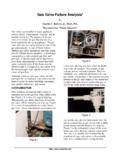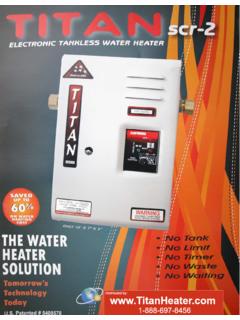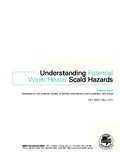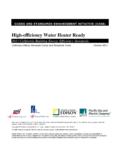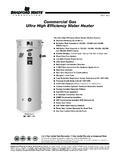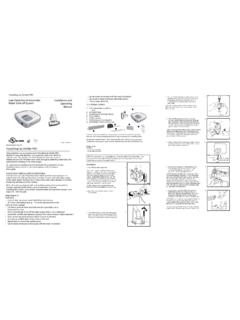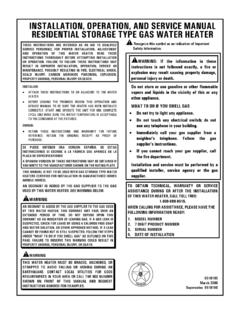Transcription of Furnace and Water Heater Related Fires - …
1 Furnace and Water Heater Related Fires * By Charles C. Roberts, Jr., , *Reprinted from Claims Magazine Furnace and Water Heater Related Fires in resi-dential buildings continue to be a cause of loss to many insurers. The previous article: Fur-nace Related Fires , reviewed several examples of Furnace Related Fires . The following are some additional case studies. Figure 1 shows a Figure 1 Figure 2 Furnace that sustained a relatively minor fire that initiated in the vicinity of the high voltage module that drives the spark ignition system. The arrow in Figure 2 points to the badly damaged module which was the ignition source of the fire . Although the direct damage to the home from the fire was minimal, the induced damage was substantial.
2 The home was unoccupied while the insured was on va-cation during the winter. The Furnace caught fire but fortuitously self extinguished from lack of fuel in the vicinity of the fire origin. This caused the Furnace to be inoperative, re-sulting in severe Water damage to the home once the frozen Water pipes thawed. The exact cause of the failure of the ignition module could not be determined because of severe damage to the unit from the fire . Figure 3 is a view of an old forced air Furnace in a home that was badly damaged by a fire . Figure 4 is a view of a typical floor heating duct register that is badly burned. Figure 5 is a view of another register that is connected to the forced air system and is in good condi-tion. Did the Furnace overheat and cause a fire ? The controls and burner which were lo-cated at the lower portion of the Furnace were in good condition.
3 Testing showed no mal-function in the burner gas valve or limit switches. The most severely burned areas were near a few registers on the forced air ducting that was far away from the Furnace . If the Furnace was the heat source causing se-vere pyrolysis at the registers, how come the wood near the burners or the wood near some other registers is not pyrolyzed. This is a vio-lation of the principles of heat transfer since heat does not naturally flow from a cold source to a hot source. Chemical analysis in Figure 3 Figure 4 Figure 5 the vicinity of the badly burned registers con-firmed the existence of an accelerant. Figure 6 is a view of a home after a natural gas explosion had occurred. A fire resulted but was quickly extinguished by the fire depart-ment.
4 The Furnace and Water Heater were Figure 6 Figure 7 Figure 8 suspected as having malfunctioned but no ap-parent deficiencies were found. Within a week, two more homes on the same block suf-fered explosions. Suddenly the focus of the investigation was directed toward the gas util-ity piping. The gas main was excavated and several cracks were found in the piping like that shown in Figure 7. Figure 8 is a view of a typical part of the gas main showing markings indicative of having been struck by an excava-tor. About 10 to 15 years before the loss, wa-ter pipes had been placed in the ground next to the gas main. Apparently the excavator had struck the gas piping during installation caus-ing random cracks throughout the piping sys-tem. Seasonal soil movements enlarged the cracks which began to leak natural gas more profusely.
5 Some of the residents noticed brown areas on their lawns despite every ef-fort to properly care for the lawn during the summer. This resulted from natural gas filter-ing through the soil to the atmosphere. How-ever, when the winter frost layer developed, the avenue of escape for the natural gas was blocked. The natural gas then moved hori-zontally, entering voids near sewer lines and other utilities, causing gas accumulation in some homes. The gas was most likely ignited by pilot systems of gas fired equipment. In another case, a Water Heater was involved in an explosion when the insured attempted to light the pilot after the propane fuel cylin-ders were replaced. The insured indicated that he did not smell any gas. Chemical analysis of gas samples from the cylinders indicated very little or no odorant was added to the gas.
6 The gas valve on the Water Heater was apparently on recall as a result of a pro-pensity to remain open when the pilot light extinguished. The insured typically would let the gas run out before replacement of the fuel cylinders, relying on the gas valve safety sys-tem to close the valve when the pilot flame was extinguished. When the new propane cylinders were connected, gas accumulated in the basement that could not be smelled by the insured because of lack of odorant. The inter-action of a sticky gas valve with the lack of odorant in the gas precipitated a hazardous environment, resulting in the loss when the insured attempted to light the pilot. It should be noted that in two of the men-tioned case studies the Furnace or Water Heater did not cause the loss. It is not unusual for the Furnace or Water Heater to be blamed for a loss, despite a lack of supporting evi-dence.
7 Each of the case studies, however, had sufficient information to evaluate the role that the Furnace or Water Heater played in the event. _____ Charles C. Roberts, Jr. PhD. is a registered profes-sional engineer at C. Roberts Consulting Engineers, Inc., Big Rock, IL 60511 and may be reached at 630/556-3039 or
